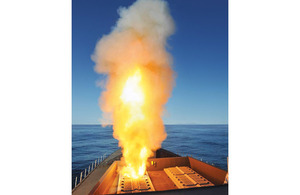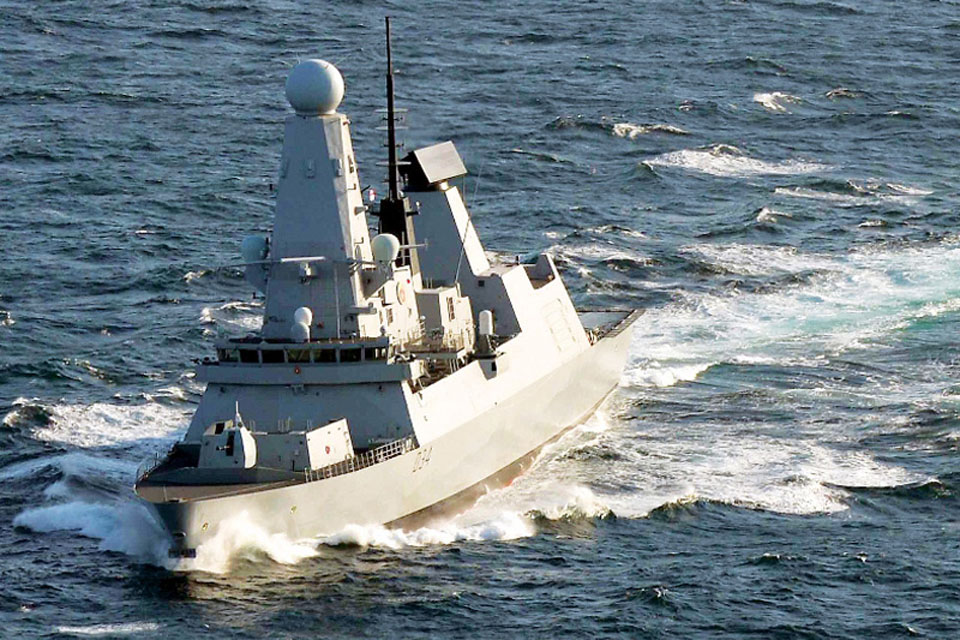HMS Diamond fires Sea Viper missile for first time
HMS Diamond has proved her fighting mettle by testing her missile system for the first time off the Outer Hebrides.

HMS Diamond firing Sea Viper for the first time [Picture: LA(Phot) Ben Sutton, Crown Copyright/MOD 2012]
The third of the Royal Navy’s cutting-edge Type 45 destroyers blasted a Sea Viper missile out of her silo at three times the speed of sound, obliterating the jet drone target in the sky above.
The successful firing of Sea Viper means that HMS Diamond is now ready to take her place as a fully operational warship, capable of deploying anywhere across the world.
YouTube video: HMS Diamond Fires Sea Viper Missile for the First Time
Her Commanding Officer, Commander Ian Clarke, said:
I am immensely proud of what my ship’s company has accomplished in such a short space of time. Ever since I took command of this ship in 2010 my focus has been to see the ship declared ready for operations within this time scale.
Our job when we deploy will be to bring stability and security to international trade routes and protect our nation’s interests abroad; a job we are now trained and ready to do.
Sea Viper is a state-of-the-art air defence weapons system which is a combination of Aster missiles, Sampson radar (the spinning ball on top of the mast), a combat and command system, and the silo on the forecastle containing the Sylver vertical missile launcher.

HMS Diamond [Picture: LA(Phot) Ben Sutton, Crown Copyright/MOD 2012]
All of this can destroy a target the size of a cricket ball travelling at three times the speed of sound through the air.
In this case, HMS Diamond’s prey was a Mirach drone - a 13-foot (4m) remote-controlled jet that can fly at speeds of up to 600mph (966km/h) at altitudes as low as 10ft (3m) or as high as 14,000ft (4km) for 90 minutes.
The successful Sea Viper firing was the culmination of a busy year for Diamond. She was accepted into the Navy 11 months ago and is due to deploy later this year - making her the fastest warship in recent memory to go from ‘joining up’ to deploying.
Along the way the ship’s company has worked tirelessly to meet all the strict training requirements as well as making sure the ship remains at the highest state of maintenance.
That training was largely delivered by staff from the Flag Officer Sea Training organisation in Plymouth.
They tested HMS Diamond in everything she is expected to encounter from skirmishes with fast attack craft to high-intensity conflict as part of a task group against sustained air, surface and submarine attacks simulated by real jets, ships and submarines.
The ship’s company proved they could deal with these evolutions, as well as fighting fires and floods at the same time. But war-fighting is not the only task a modern and versatile ship like HMS Diamond may be called upon to undertake, so she was assessed on how she dealt with humanitarian operations like disaster relief and civilian evacuations.
Her training concluded last week, taking part in the biggest military exercise in Europe so far this year, Joint Warrior.
Diamond joined ships from six different nations, as well as land and air units operating in and around western Scotland, as part of a fictional task group conducting peacekeeping operations in an unstable and volatile environment.
As well as final preparations for her deployment later this spring, the ship’s name means she will also be playing an important role in the Queen’s Diamond Jubilee celebrations.